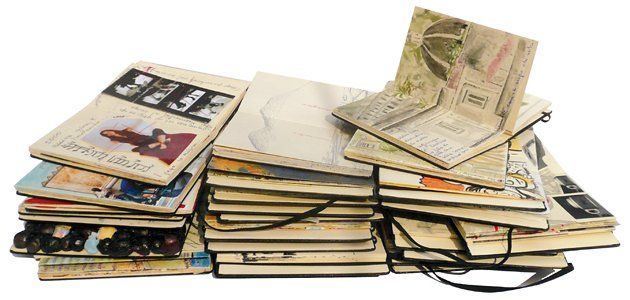
One evening in 1995, an Italian named Maria Sebregondi was reading The Songlines, by travel writer Bruce Chatwin. In the book, Chatwin laments the disappearance of a hardcover notebook, bound in oilcloth, called a moleskine. Each time Chatwin returned to Paris, he would pick up a fresh supply from his favorite stationers. "The pages were squared and the end-papers held in places with an elastic band," he writes. "I wrote my name and address on the front page, offering a reward to the finder. To lose a passport was the least of one's worries; to lose a notebook was a catastrophe."
But the moleskines were becoming scarce. "I'd like to order a hundred," Chatwin says to the seller. "A hundred will last me a lifetime." The bookseller tells Chatwin that the manufacturer had died and his heirs sold the business. "She removed her spectacles and, almost with an air of mourning, said, 'Le vrai moleskine n'est plus.'"
As it turns out, Chatwin wasn't the only noteworthy moleskine devotee. Sebregondi discovered that a great many artists and writers associated with the 20th-century avant-garde had used moleskines for drawing or writing. Henri Matisse, Pablo Picasso, Ernest Hemingway, André Breton—all had moleskines as sketchbooks and journals. "Here was a story steeped in culture," she says, "rich in imagination and tied to a grand historical tradition. So why not bring it back to life?"
Sebregondi brought her idea to Modo & Modo, a small Milanese stationery company. The firm's founder was deeply impressed. Modo & Modo trademarked the brand and located a Chinese manufacturer capable of stitching together and assembling the books to their detailed specifications. The first Moleskines arrived to be hand-finished in Milan in 1997, and the firm sold 5,000 of them to Italian distributors. By the next year, the number ballooned to 30,000. In 1999, the company expanded across Europe and sales took off. Moleskines can now be found in 61 different countries. Modo & Modo, which was bought by an investment fund in 2006 for €60 million, has also diversified to produce diaries, guides, and lavish limited-edition Moleskines.
A good deal of the Moleskine's success, Sebregondi believes, is tied to the modern-day phenomenon of culture-worshiping nomads who want an attractive writing accessory to bring with them on their Lonely Planet travels. It's these consumers who first evangelized about the Moleskine notebooks online, starting in the early 2000s. "There were all these different groups of people talking excitedly" about the Moleskines, says Sebregondi. "Many of them were young people working with computers and information technology. It was as if they were rediscovering the pleasure of direct experience, of going around writing things down by hand."
One of the most popular fan websites, Moleskinerie.com, was started by photographer Armand Frasco. He booked the domain name in 2004, after a cursory Google search revealed many people were just as mad about Moleskines as he was. Within weeks, Moleskinerie.com attracted 5,000 visitors a day from all over the world. Since then, Chinese fans have set up Moleskiner.cn while Japanese can go to Moleskinerie.jp; fan sites are mushrooming everywhere the notebooks are sold. Then there are the dozens of blogs and more than 50 Facebook groups, all dedicated to the love of Moleskine. Despite spending next to nothing on traditional marketing, Moleskine now sells around 10 million of its notebooks every year. That's enough to last contemporary travel writers a hundred thousand lifetimes. Chatwin would surely be envious.
Harkin is the author of Niche: Why the Market No Longer Favours the Mainstream, published by Little, Brown.
Uncommon Knowledge
Newsweek is committed to challenging conventional wisdom and finding connections in the search for common ground.
Newsweek is committed to challenging conventional wisdom and finding connections in the search for common ground.
About the writer
To read how Newsweek uses AI as a newsroom tool, Click here.








